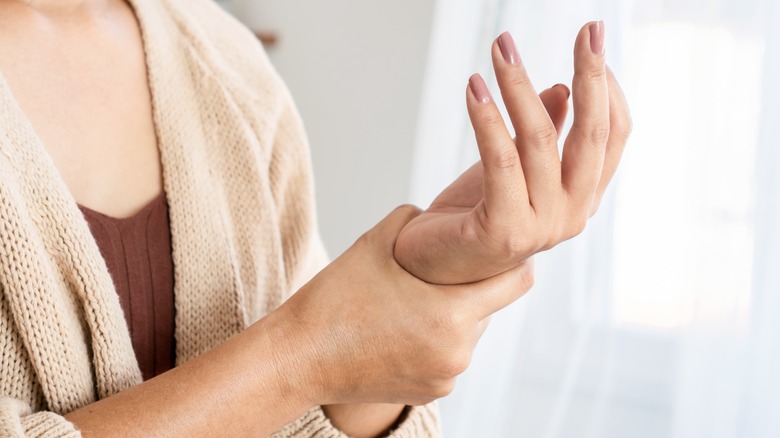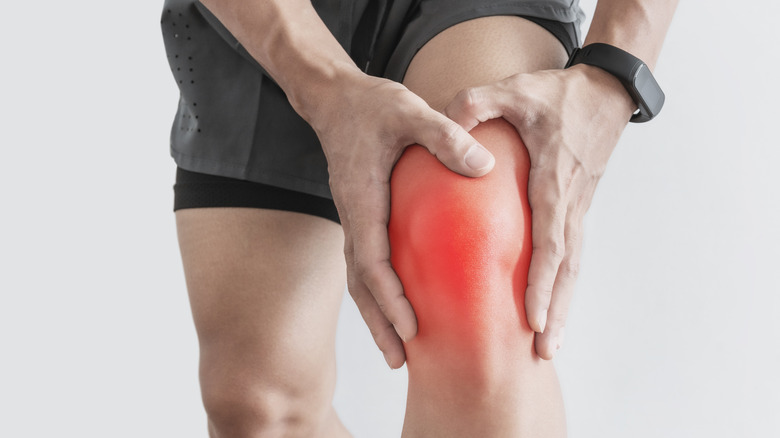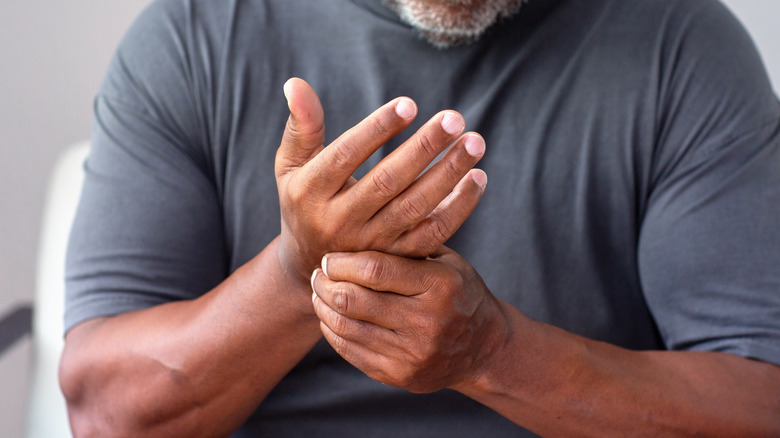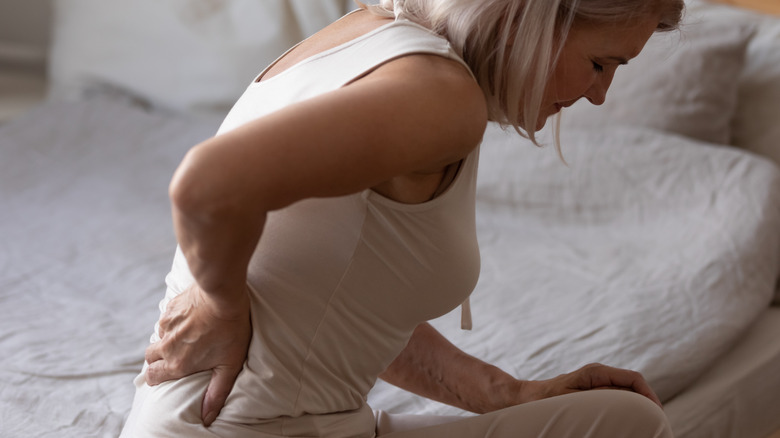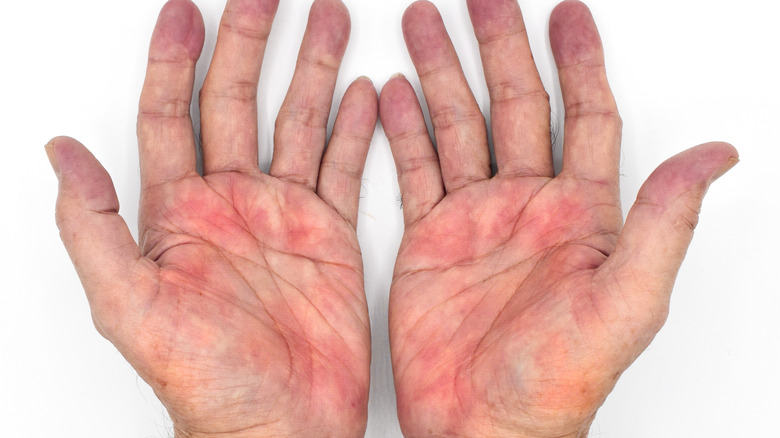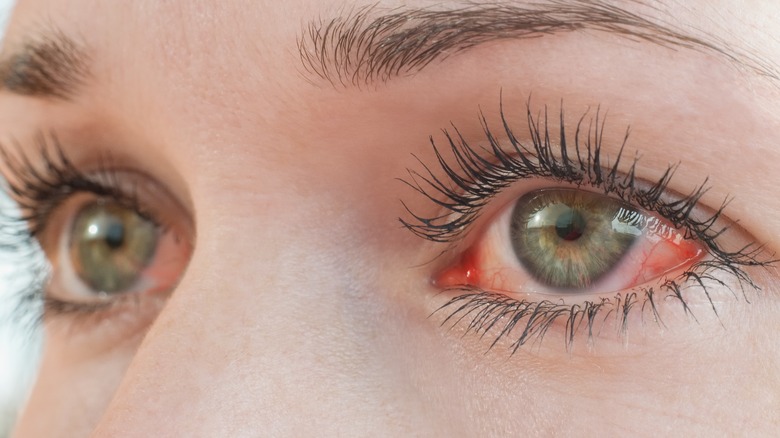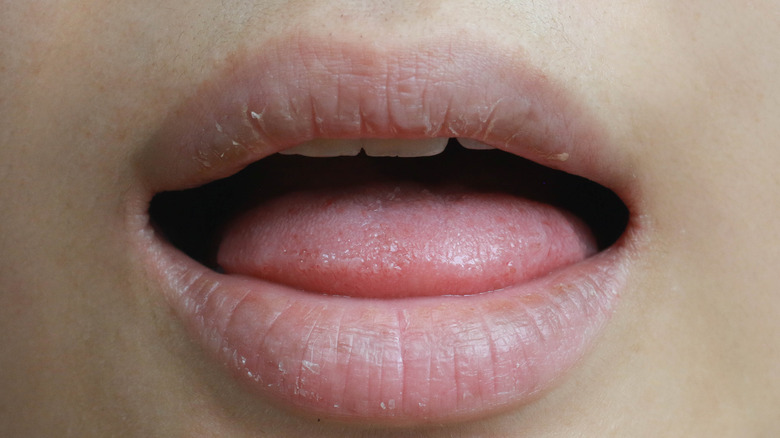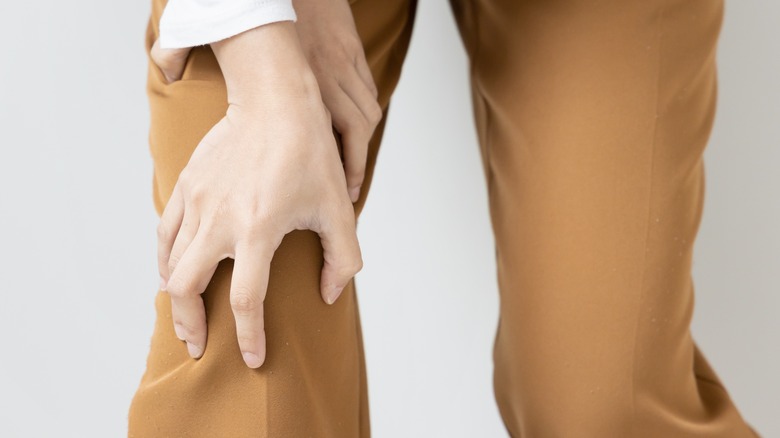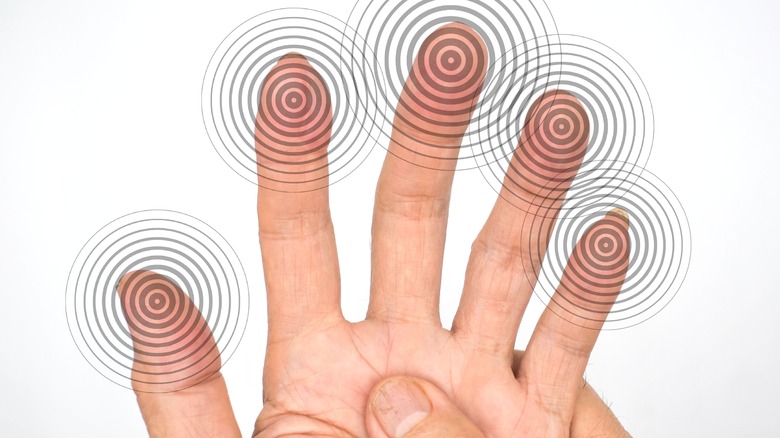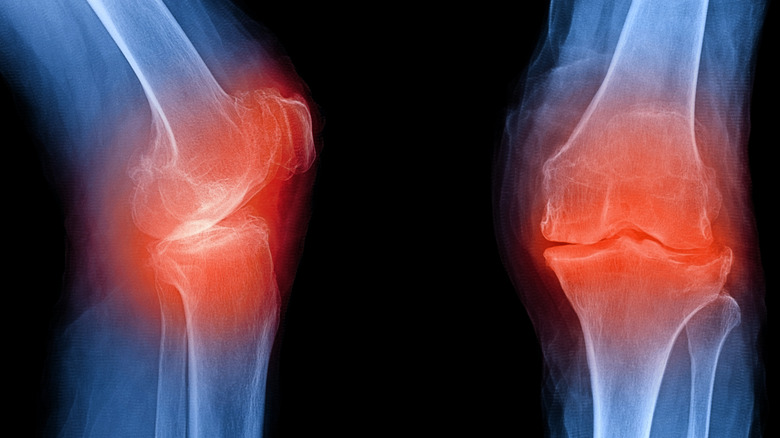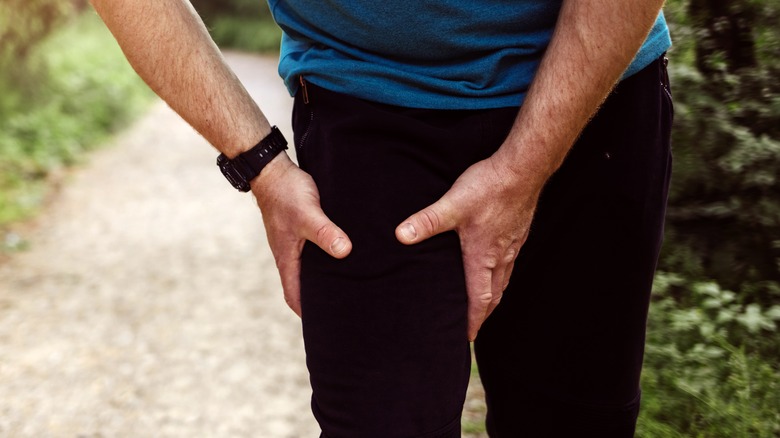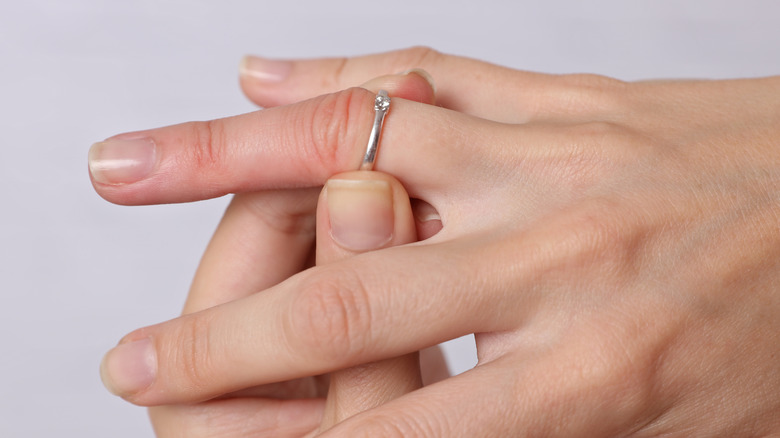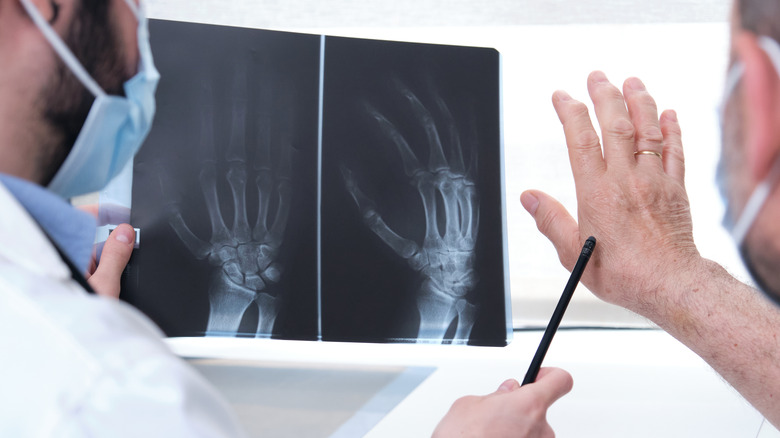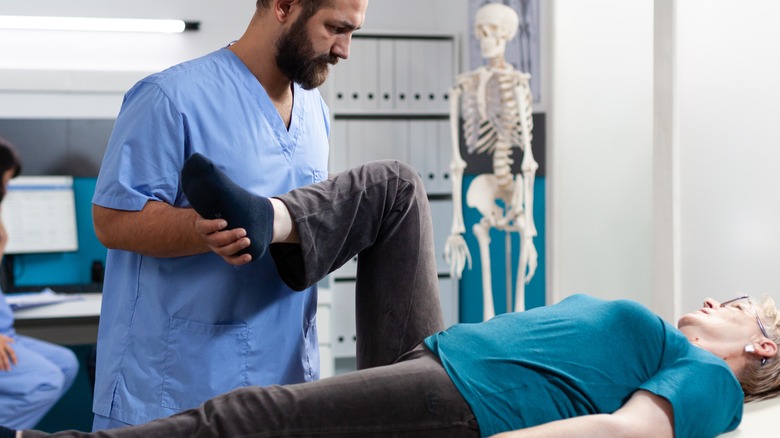Early Signs You Could Be Developing Arthritis
Arthritis refers to inflammation of the joints, which leads to pain, stiffness, and decreased mobility (via CDC). There are over 100 types of arthritic conditions, including osteoarthritis and rheumatoid arthritis.
Osteoarthritis is the most common among the different types of arthritis (via Mayo Clinic). It results from the wear and tear of the body's skeletal system, and generally affects the joints of the hands, knees, hips, and the spine (via MyHealth.Alberta.ca). Meanwhile, rheumatoid arthritis (which is also common, yet less prevalent than osteoarthritis) is an autoimmune and inflammatory disease that affects the joints as well as other parts of the body. If you are a woman aged between 40 and 60 years old, you are more likely to develop rheumatoid arthritis (via Versus Arthritis). The main difference between the two is the cause behind the joint inflammation: Rheumatoid arthritis is induced by the immune system attacking the cells of the joints, whereas osteoarthritis occurs from bone and cartilage deterioration (a process of aging).
Early signs of rheumatoid arthritis include fatigue, weakness, and tenderness in certain body areas (via Healthline). However, it doesn't necessarily include swelling at first. Within weeks (or months) of this malaise, a person may begin to see signs of inflammation and redness as well as tingling and numbness. Other symptoms at this stage include general joint pain and stiffness (especially in the morning), as well as a decreased range of motion. Osteoarthritis symptoms, on the other hand, take more time to develop (via Mayo Clinic).
Increased fatigue and flu-like symptoms
Increased fatigue is not uncommon for people with rheumatoid arthritis, according to a 2020 publication by the Institute for Quality and Efficiency in Health Care. That's because inflammation in the body is exhausting — and this overwhelming feeling of tiredness occurs early in the disease.
With low energy levels, the arms and legs may even feel heavy and difficult to move, akin to symptoms of the flu (via Versus Arthritis). It can also affect how well you can focus. Occasional low-grade fevers as well as a loss of appetite are also common to the condition (via National Institute of Arthritis and Musculoskeletal and Skin Diseases). According to Healthline, a mild fever can result from a compromised immune function and inflammatory conditions of the joints, both of which are present in rheumatoid arthritis. Loss of appetite is said to be associated with discomfort and pain (via MyRATeam). However, the person's appetite may return once the pain and inflammation subside.
Pain in a joint that was previously injured
Joints with injuries (versus those unaffected) are seven times more likely to develop arthritic pain (via Goshen Health). That's why it is so important to wear protective knee, elbow, and/or wrist gear when playing sports (via Blue Cross Blue Shield Minnesota).
And while any kind of joint trauma or injury can progress into arthritis, it is generally dislocations or fractions that are most common to post-traumatic arthritis, which is defined as stiffness and pain in joints post-injury (via Cleveland Clinic). This causes more rapid wear and tear of the skeletal and connective tissue, a complication of osteoarthritis (via Goshen Health). With that said, it must be noted that any kind of joint trauma can lead to inflammation, which is a typical symptom of arthritis.
Post-traumatic arthritis can manifest within months or even years of the initial injury (via Midwest Center for Joint Replacement). As such, arthritis can affect anyone at any age.
Tenderness in fingers and toes
Rheumatoid arthritis targets the linings of your joints, affecting the smaller joints first (via Mayo Clinic). And while you may not see any bone deformities during the early onset of this disease, swelling of the joint can erode bone over time and result in malformation in your fingers and toes.
The early stages of rheumatoid starts with the tenderness of those joints (via Arthritis Foundation). Swelling will follow as the disease progresses. You may feel it in the middle and base of your fingers, as well as the base of your toes (via Medical News Today). You may likely put more weight on your heels to avoid pressure on the toes. What this means is that everyday tasks can become more challenging. The individual joints of your fingers are part of a complex structure, allowing a wide range of precise movement from grasping and holding to typing and texting (via Institute for Quality and Efficiency in Health Care).
When it comes to avoiding pressure on the toes, utilizing your big toe well is more necessary than you may think. It is important for shock absorption and balance (via Athletico Physical Activity). Thus, everyday activity such as walking, standing, and jogging can become a little off.
Morning stiffness
Have you felt a bit stiff in the morning? Aging can wear those cushions of our joints and reduce their natural lubrication (via WebMD). Additionally, your joints can stiffen from inactivity. Tight, creaky joints can stem from age-related osteoarthritis. Rheumatoid arthritis can be impactful as well, as inflammation can cause those joints to tighten. Either way, it can make it more difficult to rise and shine, especially if you are feeling a bit achy, too. As with any arthritic condition, pain and soreness may accompany it, and may be felt more frequently in the morning (via Elliott Physiotherapy).
With osteoarthritis, morning stiffness may iron itself out once you've started moving; it may only last minutes (via NHS). With rheumatoid arthritis, however, it may take a bit longer to flex those joints, as it can last for an hour or more. If your morning stiffness lasts three days or beyond, it may be a good idea to rule out arthritis (via WebMD). Other health conditions related to stiff mornings include thyroid issues, vitamin D deficiency, fibromyalgia, and obesity.
Rashes or nodules
It may sound surprising, but skin rashes can be a sign of rheumatoid arthritis (via Arthritis Foundation). In fact, doctors may look for rashes to help in confirm a diagnosis of rheumatoid arthritis (via Water's Edge Dermatology).
Palmar erythema is one type of rash associated with rheumatoid arthritis, according to Visual Dx. Redness of the palms is a sign of this condition: more blood reaches the surface of the hands, as the small blood vessels in them become dilated (per Water's Edge Dermatology). Although this type of rash may stem from a variety of health issues, it occurs in 60% of individuals with rheumatoid arthritis.
What is unique to rheumatoid arthritis is the formation of nodules or firm lumps under the skin near the joints (via Medical News Today). These nodules occur in up to 25% of people with rheumatoid arthritis. Fortunately, these generally aren't tender. However, they can grow from the size of a pea to as large as a lemon.
Dry eyes
While rheumatoid arthritis is known for its effect on the joints, other parts of the body may also be negatively impacted by the disease (via Mayo Clinic). Take the eyes, for example: The most commonly eye issue associated with rheumatoid arthritis is dry eyes, which can result in redness and irritation. In fact, an opthamologist may suspect rheumatoid arthritis if a patient reports dryness and painful irritation at least twice a year, prompting further evaluation to confirm a diagnosis (via New Optical Palace).
Dry eyes are also common to the autoimmune disease Sjogren's syndrome, which is also associated with rheumatoid arthritis. Essentially, the same immune cells that attack your joints attack the lacrimal gland, which is responsible for producing your tears (via Creaky Joints). When the eyes can't maintain enough natural saline — that stuff your tears are made of — protection and lubrication is diminished (via Arthritis Foundation). This may happen due to the eyes being incapable of producing enough tears; it may also be the result of rapid tear evaporation (via Arthritis Foundation).
Dry mouth
Various autoimmune disorders may disrupt your salivary gland production, according to a 2013 study in Rheumatology International. This may cause a dry sensation in the mouth that isn't simply relieved with water (via Creaky Joints). Sjogren's syndrome is one such autoimmune disease that is known to affect your saliva, and this disease affects nearly one-third of individuals with rheumatoid arthritis. Hence, you may experience dry mouth, a not-so-obvious symptom of rheumatoid arthritis.
Symptoms of dry mouth include a feeling of dryness or stickiness in the oral cavity, bad breath, difficulty with chewing, swallowing, and in some cases speaking, a sore throat, and a dry or grooved tongue (via Mayo Clinic). Over time, this lack of adequate saliva can lead not just to discomfort, but also dental issues (via Rheumatoid Associates, P.C. and Osteoporosis Center). If you are experiencing stiffness in the joints as well as dry mouth, it may be time to get tested for the possibility of rheumatoid arthritis.
Reduced range of motion
It is possible to feel pain and stiffness from any new physical activity routine, especially if your body isn't used to such exercises (via CDC). With exercise modifications, warm-ups, and cool downs, this should resolve in 6 to 8 weeks, or once your body adjusts to the new level of exercise. But what are signs that your body's rigidity (and thus, reduced range of motion) may be related to arthritis?
Joint stiffness that results from arthritis will often occur in more than one joint (via Arthritis Society Canada). If it occurs in the morning and lasts for over an hour or worsens with inactivity, it may be a sign of inflammatory arthritis. Not only may it be more of a strain to flex the joints, but decreased movement will also affect the joints' nutrition and blood supply (via Southeast Orthopedic Specialists). In addition, it can lead to muscle tightness. Thus, stiff joints and reduced flexibility may lead to even greater motility issues.
If you feel your stiffness isn't exercise-related and it worsens with inactivity, you should consult your doctor.
Tingling and numbness
In addition to morning stiffness and fatigue, are you feeling any tingling and numbness around your joints? These are considered as common early signs of arthritis (via Joint Flex).
These sensations may be mild, especially when they've just started to occur. You may notice "pins and needles" or reduced sensitivity in your hands and the feet (via Medical News Today). The lack of circulation can result from nerve compression induced by joint inflammation, which is a common manifestation of rheumatoid arthritis.
To distinguish the feeling of "my hands fell asleep" from repetitive motion (carpal tunnel), your doctor will ask questions to evaluate the timing, duration, and location of the numbness (via Everyday Health). They will also access if it follows certain typical activities such as typing, texting, or blow-drying your hair. Carpal tunnel isn't uncommon for those with rheumatoid arthritis. In fact, 5% of those with rheumatoid arthritiswill develop this condition.
Grating sensation (bone spurs)
Medically referred to as osteophytes, bone spurs develop as time passes, as does the condition of osteoarthritis (via Cleveland Clinic and Mayo Clinic). The Mayo Clinic describes bone spurs as "bony projections that develop along bone edges" They often result from damaged joints observed in people with osteoarthritis. It can sometimes take years for them to be discovered in the body.
Bone spurs can appear on the hands, feet, hips, knees, shoulders, and spine (via Coastal Orthopedics). A grating sensation may be an indication of the bony growth, according to Christopher Toth, DPM, a foot and ankle surgeon for Banner Health. He points out that these bony growths tend to grow inward, and are often undetectable on our outer physique. While typically harmless on their own, they can impact your everyday routine (via Coastal Orthopedics). Pain, stiffness, and reduced mobility may result from the spur rubbing against surrounding tissue and nerves. If the spur is within the spinal column, it can impinge against those spinal nerves and result in lower back pain and mobility issues. A healthy lifestyle can help delay the symptoms and physical therapy can help (via Cleveland Clinic). Surgery is another an option for relief.
Groin pain
Groin pain is common to arthritis of the hip (via Bassett Healthcare Network). That's because bone spurs that can develop within the hip typically cause pain in the groin (via Johns Hopkins Medicine). And while bone spurs can develop gradually as time passes, the irregular shapes of the hip joint bones can cause added friction, which means the bony growth(s) can grow somewhat more rapidly. Walking or standing for lengthy periods of time can exacerbate the distress.
Both osteoarthritis and rheumatoid arthritis can contribute to pain in the groin (via Johns Hopkins Medicine). Cartilage breakdown and bone spurs can develop from either condition. Described by Arthritis Health as among the body's most vulnerable joints, the hip is highly susceptible to stress and injury. Bone spurs not only develop from degenerative processes of the areas connecting the tendon, ligament, and bone (your joints), but also from inflammatory conditions which put stress on those sites (via Rheumatology Network).
Palindromic swelling
When a patient experiences joint swelling that persists for days or weeks, clears up entirely, then returns in a similar pattern in the same area, it is referred to as palindromic swelling (via Johns Hopkins Medicine). This is one of the typical experiences associated with rheumatoid arthritis.
During a palindromic flare-up, the joints and tendons are swollen, stiff, tender, and painful, according to Versus Arthritis. In addition, the skin around the area may appear reddened. These attacks, however, are not thought to cause joint damage. Fatigue may also follow after a flare-up, and may affect your disposition and ability to work.
With that said, the pattern of the swelling — how often it occurs, the length of time it persists, and specific joints involved — differs from patient to patient. The most common joints affected by palindromic swelling are the fingers, wrists, and knees (via the National Center for Advancing Translational Sciences).
How is arthritis diagnosed?
As there are over 100 varieties of arthritis, it can be difficult to diagnose (via Johns Hopkins Medicine). Thus, your doctor will review your symptoms and your medical history, complete an examination focusing on your joints, order lab tests, x-rays, and ultrasounds if necessary, and possibly remove fluid from a joint (a procedure known as arthrocentesis). Arthrocentesis is performed to get a better understanding as to why a joint is swollen or to simply relieve some of the pain (via Kids Health).
When it comes to imaging, a doctor may be able to use a routine x-ray to access the degree of bone degradation, in order to determine the extent of a patient's arthritis (via HSS). However, symptoms of joint pain and inflammation may be observed even before standard x-rays can detect early bone and cartilage injury or wear-and-tear. In such cases, an MRI (magnetic resonance imaging), CT scans (computerized tomography), or ultrasounds may be ordered. An MRI can detect early indications of arthritis such as fluid build-up around the joints as well as inflammation. It can produce a more highly detailed image of the soft tissue in the joints via high-frequency radio waves and a strong magnetic field (via Mayo Clinic). CT scans can detect bone spurs, and ultrasounds can detect synovial cysts that are sometimes present in osteoarthritis patients (via HSS).
Treatment options and lifestyle management
Various treatment options are available to those suffering arthritis pain (via Mayo Clinic). Sometimes, more than one treatment may be prescribed (and some may be prescribed in conjunction) in order to identify the most effective course of action for the patient.
Medications for arthritis include NSAIDs (nonsteroidal anti-inflammatory drugs) for reducing inflammation and pain. Menthol or capsaicin-based creams or ointments may help aleviate the sensation of pain. They do so by blocking the transmission of pain-signaling responses in the body. Steroids may be provided to help reduce joint damage and inflammation, while disease-modifying antirheumatic drugs (DMARDs) may be prescribed to delay the progression of rheumatoid arthritis and prevent irreversible damage.
Including physical therapy in the treatment plan can be beneficial for arthritis relief (via Twin Boro). An exercise routine coupled with manual therapy by the practitioner may be a beneficial aspect of the treatment and recovery process. What's more, adhering to a Mediterranean-style diet as well as aerobics, aquatics, and resistance-training is recommended as part of the 2022 integrative treatment guidelines for rheumatoid arthritis developed by the American College of Rheumatology.

